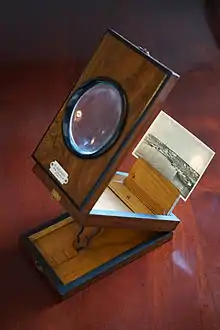Graphoscope
A graphoscope was a 19th-century device used in parlors in order to enhance the viewing of photographs and text. The graphoscope is supposed to be based on a 1864 patent of Charles John Rowsell.[1] These novelty items consisted of a single magnifying glass, often in a wooden frame, in an overall construction that could collapse into a compact rectangular form. A photo/card holder was usually also included. A KOMBI camera often had included in its design a graphoscope for better film viewing. Many devices combined a Stereoscope and Graphoscope.

Graphoscope from E. Ziegler (Paris); ca. 1880
See also
Sources
- https://web.archive.org/web/20120204093105/http://www.eyeantiques.com/ViewingInstruments/Graphoscope.htm
- http://www.bdcmuseum.org.uk/explore/item/69068/
- https://web.archive.org/web/20160305080514/http://www.georgeglazer.com/archives/decarts/instruments/stereoscope.html
- https://web.archive.org/web/20091026224453/http://geocities.com/mbarel.geo/kombi.html
- https://web.archive.org/web/20171231195539/http://courses.ncssm.edu/gallery/collections/toys/html/exhibit12.htm
References
This article is issued from Wikipedia. The text is licensed under Creative Commons - Attribution - Sharealike. Additional terms may apply for the media files.